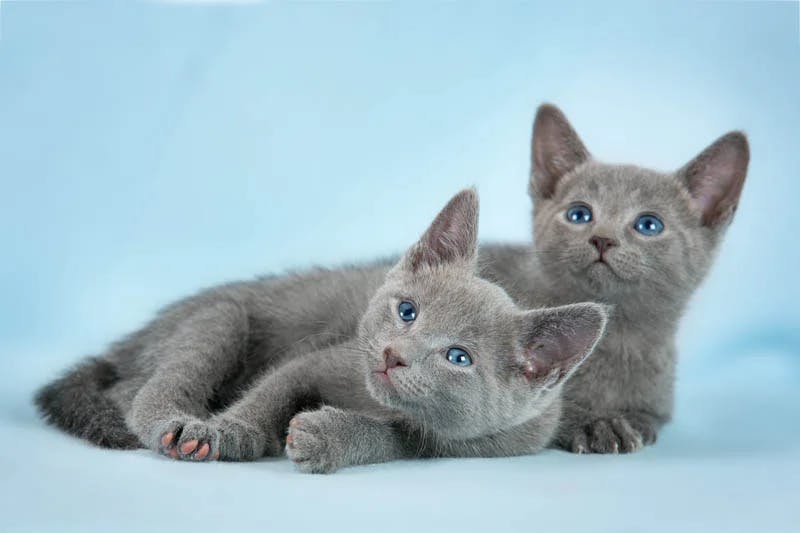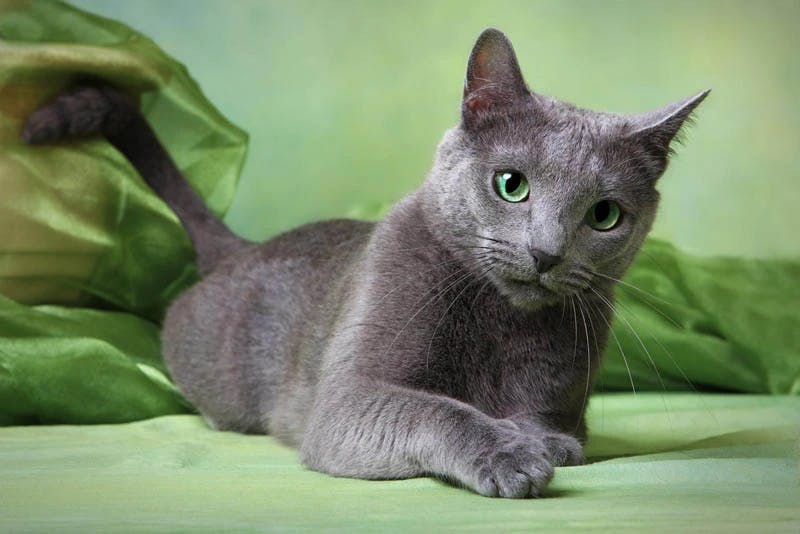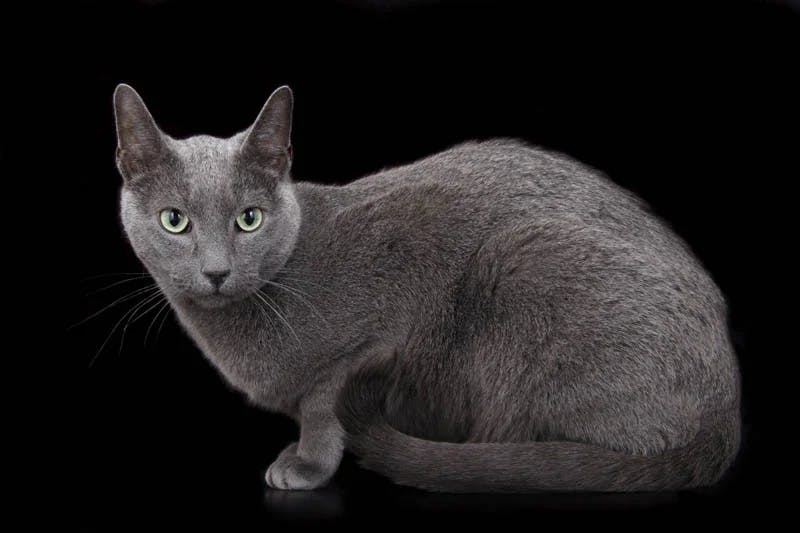Russian Blue
A Strikingly Beautiful Cat with a Shimmering Silver-Blue Coat
Russian Blue
Antonia Cirjak - Last updated on December 18th, 2021
Things you Should Know about the Russian Blue
The Russian Blue is an intelligent cat breed recognizable by its aristocratic look and silver-blue coat. They will openly show their affection to you if used to your presence but can be standoffish toward strangers.
A Russian Blue kitten is usually playful, meticulous about its hygiene, and generally simple to care for.
These cats are loyal and have a friendly, calm temper. Expect them to follow you wherever you go, sometimes even greeting you at the front door as a dog would.

Appearance Matters. What does a Russian Blue look like?
Russian Blue cats have triangular-shaped heads, and their bodies are slender and long. They have large ears, a straight nose, and a broad forehead. This makes them give off an aura of royalty.
Russian Blues are also known for their upturned mouth, which makes them have a constant subtle smile.
The Russian Blue’s green eyes are one of their most striking features. Of course, next to their gorgeous silvery coat. They are generally slender but are also quite muscular and strong.
The breed has a thick fur that makes the Russians seem more robust than they are, and this fur hides their muscular neck and shoulders.
Sometimes you might run across a Russian Blue with yellow eyes, most often a kitten. However, according to the TICA breed standard, these are considered a fault if found in adult cats of this breed.
Their fur is thick but short, plush, and blue-gray. It is known as a “double-coat.” This means that the Russian Blue has a soft undercoat, which is equal in length to the hairs of its overcoat.
The overcoat is typical with silver tips that give off a nice glow. The tail of the Russian Blue also has stripes.
What is the difference between Chartreux and Russian Blue?
All of this, combined with the dark green eyes, makes this a gorgeous cat indeed. When talking about the differences between the Chartreux and the Russian Blue, the latter has more silver-tipped hair.
The Chartreux has a medium-short coat, compared to the short one of the Russian Blue. The Korat cat also lacks the silver tips on its hair.
What colors do the Russian Blue cats come in?
The color of a Russian Blue cat can vary from light shimmering silver to a much darker slate grey. The ground color contrasts the hair tips, which are always silver and give off a glow when placed under a light source.
It gives these cats a lustrous appearance. Most Russian Blues do not have tabby markings.
It's all Personal. The Russian Blue Temperament
The Russian Blue personality is exceptionally affectionate. They become highly attached to a single pet parent but will also show affection to the entire family. Not only that, but these cats demand affection in return as well.
You might often hear people say that Russian Blues train their owners instead of the other way around, and we can’t help but agree with that statement.
These cats are social but do not mind some alone time. Sometimes they will seek out some private space where they can sleep in peace.
They won’t mind staying home alone for a while, but once you return, expect them to demand some playtime. They do not like visitors and might hide if you have a large gathering in your home.
Russian Blues need to be stimulated, both physically and mentally, to have a high quality of life. This is why you should provide them with some toys with which they can learn and play.
Can Russian Blue cats be left alone?
You can leave Russian Blue cats alone for longer than most other breeds since they are highly independent.
Just make sure to leave them some toys and a cat scratching post, and they should be fine. These cats have a lot of energy; they love to jump around and climb furniture.

Caring for your Russian Blue
As mentioned, Russian Blue cats are easily recognizable by their shimmery blue trademark coat.
It is easy to take care of this coat since it is short and dense. It requires minimal grooming, and they do not shed much at all. Just make sure to brush it occasionally.
Many believe the Nebelung cat to be a long-haired Russian Blue. However, it is a completely different breed. They are similar and share some genes, but these cats have several unique features.
You should trim your Russian Blue’s nails regularly and check its ears for any debris or dirt. Gently clean anything you find using a pet ear cleaner and a cotton ball. Never use a cotton swab.
Are Russian Blue cats really hypoallergenic?
You will often see Russian Blue cats on the lists of hypoallergenic cat breeds. However, no breed is truly and completely non-allergenic. Still, if you suffer from allergies, you can live with certain cats, and the Russian Blue is one such breed.
The main cause of cat allergies is cat dander, which contains this protein often. Russian Blue cats hardly shed at all and do not produce a lot of the Fel D1 protein responsible for allergic reactions.
Since the Russian Blue does not produce much of it, you can live with one if your allergies are not severe.

The Health and Happiness of your Russian Blue
The Russian Blue is one of the rare purebred cats that is not linked to genetically-based disorders. These cats are generally quite healthy.
The Russian Blue cat lifespan is quite long, and many will live to be 15 or even more.
These cats also enjoy food, so be careful not to overfeed them. The best way to keep a Russian Blue healthy is to keep it lean. This way, you can avoid diabetes, arthritis, and heart disease.
How Do I Find Reputable Russian Blue Breeders?
These cats are intelligent, affectionate, and playful. This makes them perfect pets, so it’s no wonder they are so popular. If you are looking to find a breeder and get one of these kittens as your pet, you have come to the right place.
Take a look at our list of Russian Blue breeders. There you will be able to find breeders that are nearest to your location and pick the best one for you.
These kittens are usually priced between $800 and $1,200. By getting them from a breeder you are ensuring that your pet will have fewer health issues and by that a much easier life.
Feline History. Where does the Russian Blue come from?
The Russian Blue originated in Russia, in the port of Arkhangelsk, which is why many referred to it as the Archangel Blue at first. Sailors brought it to England and Northern Europe in the 1860s. Pretty soon, it made its first show debut in 1875 at the Crystal palace in England.
Before World War II, these cats were mainly developed in Russia and Scandinavia. Once the war was over, they underwent more concentrated breeding in the United States. The Russian Blue we know today has evolved from the Scandinavian and English Russian Blues.
There are also Russian Whites and Russian Blacks created through cross-breeding. These breeds were accepted by cat fanciers by the late 1970s.
However, officially only the Russian Blue is accepted by the Cat Fanciers’ Association in North America.
